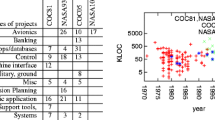Abstract
This paper summarizes several classes of software cost estimation models and techniques: parametric models, expertise‐based techniques, learning‐oriented techniques, dynamics‐based models, regression‐based models, and composite‐Bayesian techniques for integrating expertise‐based and regression‐based models. Experience to date indicates that neural‐net and dynamics‐based techniques are less mature than the other classes of techniques, but that all classes of techniques are challenged by the rapid pace of change in software technology. The primary conclusion is that no single technique is best for all situations, and that a careful comparison of the results of several approaches is most likely to produce realistic estimates.
Similar content being viewed by others
References
Abdel-Hamid, T. (1989a), "The Dynamics of Software Project Staffing: A System Dynamics-based Simulation Approach," IEEE Transactions on Software Engineering, February.
Abdel-Hamid, T. (1989b), "Lessons Learned from Modeling the Dynamics of Software Development," Communications of the ACM, December.
Abdel-Hamid, T. and S. Madnick (1991), Software Project Dynamics, Prentice-Hall, 1991.
Abdel-Hamid, T. (1993), "Adapting, Correcting, and Perfecting Software Estimates: A Maintenance Metaphor," IEEE Computer, March.
Abdel-Hamid, T. and S. Madnick (1993), "Modeling the Dynamics of Software Reuse: An Integrating System Dynamics Perspective," Presentation to the 6th Annual Workshop on Reuse, Owego, NY, November.
Abts, C. (1997), "COTS Software Integration Modeling Study," Report prepared for USAF Electronics System Center, Contract No. F30602–94-C-1095, University of Southern California.
Abts, C., B. Bailey, and B. Boehm (1998), "COCOTS Software Integration Cost Model: An Overview," In Proceedings of the California Software Symposium, 1998.
Albrecht, A. (1979), "Measuring Application Development Productivity," In Proceedings of the Joint SHARE/GUIDE/IBM Application Development Symposium, October, pp. 83–92.
Baird, B. (1989), Managerial Decisions Under Uncertainty, Wiley, New York, 1989.
Banker, R., R. Kauffman, and R. Kumar (1994), "An Empirical Test of Object-Based Output Measurement Metrics in a Computer Aided Software Engineering (CASE) Environment," Journal of Management Information System.
Boehm, B. (1981), Software Engineering Economics, Prentice-Hall.
Boehm, B., B. Clark, E. Horowitz, C. Westland, R. Madachy, and R. Selby (1995), "Cost Models for Future Software Life-cycle Processes: COCOMO 2.0," Annals of Software Engineering 1, Special Volume on Software Process and Product Measurement, J.D. Arthur and S.M. Henry, Eds., 45–60.
Box, G. and G. Tiao, (1973), Bayesian Inference in Statistical Analysis, Addison-Wesley, Reading, MA.
Briand, L., V. Basili, and W. Thomas (1992), "A Pattern Recognition Approach for Software Engineering Data Analysis," IEEE Transactions on Software Engineering 18, 11, November.
Brooks, F. (1975), The Mythical Man-Month, Addison-Wesley, Reading, MA.
Cash, J. (1979), "Dallas Tire Case," Harvard Business School.
Chidamber, S. and C. Kemerer (1994), "A Metrics Suite for Object Oriented Design," CISR WP No. 249 and Sloan WP No. 3524–93, Center for Information Systems Research, Sloan School of Management, Massachusetts Institute of Technology.
Chulani, S. (1997), "Modeling Defect Introduction," In California Software Symposium, November.
Chulani, S. (1998), "Incorporating Bayesian Analysis to Improve the Accuracy of COCOMO II and Its Quality Model Extension," Ph.D. Qualifying Exam Report, University of Southern California, February.
Chulani, S., B. Boehm, and B. Steece (1998), "Calibrating Software Cost Models Using Bayesian Analysis," Technical Report, USC-CSE–98–508, June. To appear in IEEE Transactions on Software Engineering, Special Issue on Empirical Methods in Software Engineering.
Clark, B., S. Chulani, and B. Boehm (1998), "Calibrating the COCOMO II Post Architecture Model," In International Conference on Software Engineering, April.
Forrester, J. (1961), Industrial Dynamics, MIT Press, Cambridge, MA.
Gray, A. and S. MacDonell (1996), "A Comparison of Techniques for Developing Predictive Models of Software Metrics," Information and Software Technology 39, 1997.
Helmer, O. (1966), Social Technology, Basic Books, NY.
Henderson-Sellers, B. (1996), Object Oriented Metrics-Measures of Complexity, Prentice Hall, Upper Saddle River, NJ.
Jensen R. (1983),"An Improved Macrolevel Software Development Resource Estimation Model," In Proceedings of 5th ISPA Conference, April, pp. 88–92.
Jones, C. (1997), Applied Software Measurement, McGraw Hill.
Judge, G., W. Griffiths, and C. Hill (1993), Learning and Practicing Econometrics, Wiley, New York.
Kauffman, R. and R. Kumar (1993), "Modeling Estimation Expertise in Object Based ICASE Environments," Stern School of Business Report, New York University, January.
Khoshgoftaar, T., A. Pandya, and D. Lanning (1995), "Application of Neural Networks for Predicting Program Faults," Annals of Software Engineering 1.
Leamer, E. (1978), Specification Searches, Ad hoc Inference with Nonexperimental Data, Wiley Series, Wiley, New York.
Madachy, R. (1994), "A Software Project Dynamics Model for Process Cost, Schedule and Risk Assessment," Ph.D. Dissertation, University of Southern California.
Madachy, R. (1999), CS577a class notes, University of Southern California, 1999.
Minkiewicz, A. (1998), "Measuring Object Oriented Software with Predictive Object Points," PRICE Systems.
Nelson, E. (1966), "Management Handbook for the Estimation of Computer Programming Costs," Systems Development Corporation, October.
Park R. (1988), "The Central Equations of the PRICE Software Cost Model," In 4th COCOMO Users' Group Meeting, November.
Putnam, L. and W. Myers (1992), Measures for Excellence, Yourdon Press Computing Series.
Rubin, H. (1983), "ESTIMACS," IEEE, 1983.
SELECT (1998), "Estimation for Component-based Development Using SELECT Estimator," SELECT Software Tools, website: http://www.select.com.
Shepperd, M. and M. Schofield (1997), "Estimating Software Project Effort Using Analogies," IEEE Transactions on Software Engineering 23, 12.
Symons (1991), Software Sizing and Estimating-Mark II FPA, Wiley, UK.
USC-CSE (1997), "COCOMO II Model Definition Manual," Center for Software Engineering, Computer Science Department, University of Southern California, Los Angeles, CA, website: http://sunset.usc.edu/COCOMOII/cocomo.html.
Weisberg, S. (1985), Applied Linear Regression, 2nd Edition, Wiley, New York, NY.
Wittig, G (1995), "Estimating Software Development Effort with Connectionist Models," Working Paper Series 33/95, Monash University.
Author information
Authors and Affiliations
Rights and permissions
About this article
Cite this article
Boehm, B., Abts, C. & Chulani, S. Software development cost estimation approaches — A survey. Annals of Software Engineering 10, 177–205 (2000). https://doi.org/10.1023/A:1018991717352
Issue Date:
DOI: https://doi.org/10.1023/A:1018991717352




